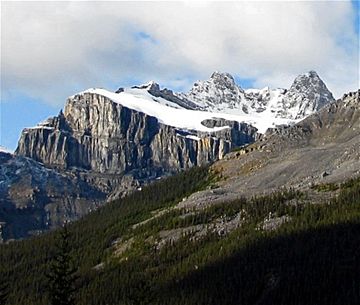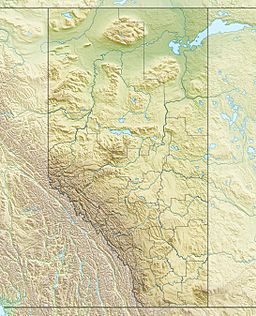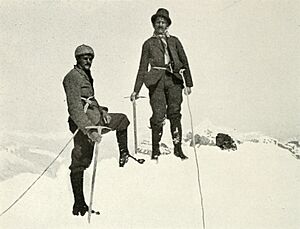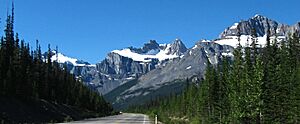Kaufmann Peaks facts for kids
Quick facts for kids Kaufmann Peaks |
|
|---|---|

Kaufmann Peaks seen from Icefields Parkway
|
|
| Highest point | |
| Elevation | 3,110 m (10,200 ft) |
| Prominence | 184 m (604 ft) |
| Parent peak | Mount Sarbach (3155 m) |
| Listing | Mountains of Alberta |
| Geography | |
| Location | Alberta, Canada |
| Parent range | Waputik Mountains Canadian Rockies |
| Topo map | NTS 82N15 |
| Geology | |
| Age of rock | Cambrian |
| Type of rock | Sedimentary |
| Climbing | |
| First ascent | 1927 by D. Duncan, Ernest Feuz |
| Easiest route | technical climb |
Kaufmann Peaks is a mountain with two main tops, or "summits." The higher one is 3,110 metres (about 10,203 feet) tall, and the other is 3,094 metres (about 10,151 feet) tall. These peaks are part of Banff National Park in the Canadian Rockies in Alberta, Canada.
The peaks sit on a ridge between two river valleys: the Howse River valley and the Mistaya River valley. The closest taller mountain is Mount Sarbach, which is about 2 kilometres (1.2 miles) to the northwest. Epaulette Mountain is right next to Kaufmann Peaks, to the southeast. You can find Kaufmann Peaks south of Saskatchewan Crossing, which is where the Icefields Parkway meets the David Thompson Highway.
History of Kaufmann Peaks
The South Peak, which is 3,110 metres tall, is named after Hans Kaufmann (1874-1930). He was a famous mountain guide from Switzerland. Hans was one of two brothers who were very popular guides. Between 1901 and 1904, Hans Kaufmann was the first person to climb twelve different mountains in the Rockies.
The North Peak, which is 3,094 metres tall, is named after Christian Kaufmann (1872-1939). He was Hans's half-brother. Christian was the first to climb 36 different mountains in the Canadian Rockies! He did 15 of these first climbs in 1901 and 10 more in 1902.
The very first time someone climbed Kaufmann Peaks was in 1927. This climb was done by D. Duncan and a guide named Ernest Feuz. The idea to name the mountain after the Kaufmann brothers came from James Outram in 1903. The name was officially chosen in 1920 by the Geographical Names Board of Canada.
How Kaufmann Peaks Were Formed (Geology)
Like other mountains in Banff Park, Kaufmann Peaks are made of sedimentary rock. This type of rock forms from layers of sand, mud, and tiny bits of sea creatures that settle at the bottom of ancient seas over millions of years.
These rock layers were laid down during periods called the Precambrian to Jurassic times. Later, during an event called the Laramide orogeny, these layers of rock were pushed up and folded. This massive pushing and folding created the mountains we see today.
There is also a cirque on the northeast side of Kaufmann Peaks. A cirque is a bowl-shaped hollow carved out by a glacier. This glacier is shared with Mount Sarbach.
Climate Around Kaufmann Peaks
Kaufmann Peaks is in a subarctic climate zone. This means it has very cold winters with lots of snow, and mild summers. Temperatures can often drop below -20 °C (which is -4 °F). With the wind, it can feel even colder, sometimes below -30 °C (-22 °F).
The water from melting snow and rain on Kaufmann Peaks flows into the Mistaya River and the Howse River. Both of these rivers eventually flow into the North Saskatchewan River.





